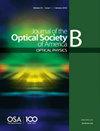全数字量子幽灵成像:教程
IF 1.9
4区 物理与天体物理
Q3 OPTICS
Journal of The Optical Society of America B-optical Physics
Pub Date : 2023-11-13
DOI:10.1364/josab.489100
引用次数: 0
摘要
与经典成像相比,量子鬼影成像具有许多优势,包括能够用一种波长探测物体,并用另一种波长记录图像,而低光子通量则能够用更少的光子探测物体,从而避免对光敏结构(如生物有机体)造成光损伤。逐渐地,幽灵成像已经从单像素扫描系统发展到二维(2D)数字投影掩模,通过更短的集成时间减少了图像重建时间。在本教程中,我们描述了一个全数字量子鬼成像实验的基本成分,并指导用户对重要的考虑和选择作出,通过实施的实际例子的帮助。我们展示了使用两种不同的2D投影掩模类型的几种图像重建算法,并讨论了每种算法的实用性。我们还讨论了一个值得注意的特定重建算法和投影掩模组合的伪影,并详细说明了如何使用该伪影来检索深埋在伪影下的图像信号。最后,我们简要讨论了用于减少图像重建时间的人工智能(AI)和机器学习技术。我们相信,对于那些希望进入该领域的人,以及那些已经在该领域并希望将人工智能和机器学习引入其工具箱的人来说,本教程将是一个有用的指南。本文章由计算机程序翻译,如有差异,请以英文原文为准。
All-digital quantum ghost imaging: tutorial
Quantum ghost imaging offers many advantages over classical imaging, including the ability to probe an object with one wavelength and record the image with another, while low photon fluxes offer the ability to probe objects with fewer photons, thereby avoiding photo-damage to light sensitive structures such as biological organisms. Progressively, ghost imaging has advanced from single-pixel scanning systems to two-dimensional (2D) digital projective masks, which offer a reduction in image reconstruction times through shorter integration times. In this tutorial, we describe the essential ingredients in an all-digital quantum ghost imaging experiment and guide the user on important considerations and choices to make, aided by practical examples of implementation. We showcase several image reconstruction algorithms using two different 2D projective mask types and discuss the utility of each. We additionally discuss a notable artifact of a specific reconstruction algorithm and projective mask combination and detail how this artifact can be used to retrieve an image signal heavily buried under artifacts. Finally, we end with a brief discussion on artificial intelligence (AI) and machine learning techniques used to reduce image reconstruction times. We believe that this tutorial will be a useful guide to those wishing to enter the field, as well as those already in the field who wish to introduce AI and machine learning to their toolbox.
求助全文
通过发布文献求助,成功后即可免费获取论文全文。
去求助
来源期刊
CiteScore
4.00
自引率
5.30%
发文量
374
审稿时长
2.1 months
期刊介绍:
The Journal of the Optical Society of America B (JOSA B) is a general optics research journal that complements JOSA A. It emphasizes scientific research on the fundamentals of the interaction of light with matter such as quantum optics, nonlinear optics, and laser physics. Topics include:
Advanced Instrumentation and Measurements
Fiber Optics and Fiber Lasers
Lasers and Other Light Sources from THz to XUV
Light-Induced Phenomena
Nonlinear and High Field Optics
Optical Materials
Optics Modes and Structured Light
Optomechanics
Metamaterials
Nanomaterials
Photonics and Semiconductor Optics
Physical Optics
Plasmonics
Quantum Optics and Entanglement
Quantum Key Distribution
Spectroscopy and Atomic or Molecular Optics
Superresolution and Advanced Imaging
Surface Optics
Ultrafast Optical Phenomena
Wave Guiding and Optical Confinement
JOSA B considers original research articles, feature issue contributions, invited reviews and tutorials, and comments on published articles.

 求助内容:
求助内容: 应助结果提醒方式:
应助结果提醒方式:


